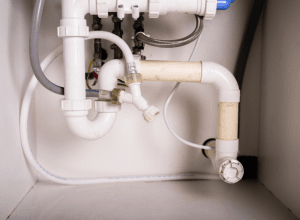Working with pipes in tight or hard-to-reach spaces can be difficult and inefficient. Traditional pipe wrenches often struggle to provide the necessary grip, which increases the risk of injury.
Offset pipe wrenches are designed to offer better leverage and access in tight spaces. Proper adjustment improves grip on tough jobs and increases efficiency in confined areas. It also extends tool life, enhances safety, and reduces user fatigue. Adjusting the wrench ensures a firm grip, reduces slippage, and prevents damage. This makes it easier to work in confined spaces, saving time and effort.
Regular adjustment also helps maintain the tool’s durability and performance. A well-adjusted wrench distributes force evenly, making it safer and reducing physical strain on the user. These benefits lead to more efficient, safer, and comfortable work.
This guide will explore the benefits of adjusting offset pipe wrenches. Understanding and applying these adjustments can optimize your work performance and achieve better results.

Offset Pipe Wrench Adjustment Benefits for Enhanced Performance
Offset pipe wrenches are specialized tools for gripping and turning pipes and other round objects. Their offset design allows for better leverage and access in confined areas where standard wrenches might not fit. These wrenches are essential for plumbers, HVAC technicians, and anyone working with piping systems.
Adjusting your offset pipe wrench correctly can make a significant difference in your work. Proper adjustment of your tools enhances their performance and ensures more efficient operation.
The following are the more specific benefits of adjusting your offset pipe wrench:
Improved Grip on Tough Jobs
Adjusting an offset pipe wrench can significantly improve its grip on tough jobs. The unique design of an offset pipe wrench allows it to bite into pipes with more force. This is especially useful when dealing with stubborn or corroded pipes that are difficult to loosen or tighten.
Similarly, properly calibrating an adjustable wrench is important for a secure grip. When the wrench jaws align perfectly with the pipe’s surface, they provide maximum contact and grip strength, preventing slippage and reducing the risk of damaging the pipe or the wrench. This careful approach is also important when adjusting strap wrenches, as the correct tension and alignment ensure a firm grip on both smooth and irregular surfaces.
Greater Efficiency in Tight Spaces
One of the standout benefits of an offset pipe wrench is its ability to work efficiently in tight spaces. Traditional pipe wrenches often struggle in confined areas where there isn’t enough room to maneuver. The offset design, however, allows for better access and leverage in cramped conditions.
Adjusting the offset pipe wrench to fit the specific dimensions of the space you’re working in can save time and effort. The angle of the offset handle provides more clearance, making it easier to turn the wrench without hitting surrounding obstacles. This feature is particularly valuable for plumbing jobs under sinks, in corners, or near walls, where space is limited.
Prolonged Tool Longevity
Adjusting your offset pipe wrench correctly can also significantly extend its lifespan. Proper adjustments ensure that the wrench operates at its optimal capacity.
Here’s how it contributes to prolonged tool longevity:
- Reduced Risk of Damage: An offset pipe wrench that is adjusted properly is less likely to slip or misalign. This reduces the frequency of repairs or replacements needed for the tool.
- Minimized Wear and Tear: Regularly adjusting the wrench keeps it in good working condition, which minimizes general wear and tear. Keeping the tool well-calibrated ensures all parts function smoothly, leading to a longer lifespan.
Increased Safety During Use
Proper adjustment of an offset pipe wrench greatly enhances safety during use. When the wrench is correctly adjusted, it performs more reliably, reducing the risk of accidents.
Here’s why this is important:
- Secure Grip: As mentioned earlier, a well-adjusted wrench provides a secure grip on pipes. This prevents slippage, which could lead to hand injuries or damage to surrounding areas. Slippage can also cause sudden movements, increasing the risk of accidental injury.
- Better Control: Adjusting the wrench for the specific task ensures better control. This reduces the likelihood of the wrench slipping or the pipe breaking, which can cause sharp fragments to fly and cause injury.
- Prevention of Tool Failure: Regular adjustments help detect wear and tear early, preventing sudden tool failure. A tool that fails during use can be hazardous, so maintaining it well is essential for safety.
Minimized User Fatigue
Properly adjusting an offset pipe wrench can minimize user fatigue, making your work easier and more comfortable. When a tool is well-adjusted, it works with you, not against you.
Here’s how:
- Optimal Leverage: An offset pipe wrench, when adjusted correctly, provides optimal leverage. This means you don’t have to exert as much force to achieve the same results and this reduces the strain on your hands and arms.
- Comfortable Grip: Proper adjustments ensure the wrench fits comfortably in your hand. A well-balanced tool reduces the likelihood of cramping and discomfort during prolonged use.
- Efficient Force Application: Adjusting the wrench so that it grips the pipe correctly allows for more efficient force application. You’ll need fewer adjustments and repositioning, which saves time and reduces physical effort.
- Ergonomic Use: Adjusting the wrench to match the specific size and type of pipe you’re working with helps maintain a more ergonomic posture. This prevents awkward positions that can lead to back or shoulder strain.
